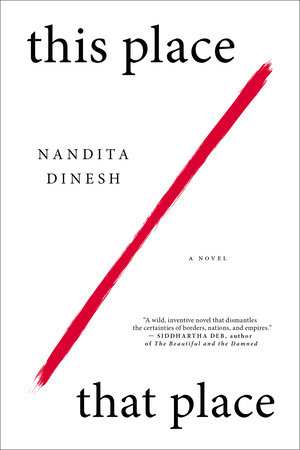This Place That Place: A Novel
- By Nandita Dinesh
- Melville House
- 320 pp.
- Reviewed by Mike Maggio
- July 12, 2022
A provocative yet exasperating “antinovel.”

A novel is defined as a work of fiction that involves a plot, a cast of characters who change over time, and a setting. Whether long or short, it typically involves a dramatic arc — exposition, development, climax, and denouement — in which the protagonist grows. By the end, there is usually some sort of epiphany that brings the narrative to its conclusion. And while some novels end in uncertainty, the reader nonetheless comes away with a sense of closure, even if they’re left in a state of wonder.
This Place That Place, Nandita Dinesh’s debut novel, follows none of these requisites. There is no plot, per se, no development, no climax, and no denouement. The characters do not grow, and the storyline is barely existent. Whatever conflict there is lies outside the environmental construct of the story (the room in which the characters exist) and is so subtle that the reader barely notices. In fact, This Place That Place may best be described as an antinovel.
So, what exactly is this antinovel about, and what is Dinesh trying to accomplish? The premise is that there are two nameless people from two nameless countries (“This Place” and “That Place”) who have come together for a wedding that never happens. Like their anonymous countries, these nondescript characters — that they are a male and a female is as much description as we’re given — have no individual personality traits and no distinguishing features to anchor the reader, except that one is from This Place and the other from That Place.
This Place, where the story is set, is occupied by That Place, which has slapped a curfew on the local population. The female character, a That Placer, sympathizes with the people of This Place and is developing a curriculum for deprogramming That Place soldiers so there will be less bloodshed during the protests that erupt from This Placers. Presumably, there is a budding romance between the This Place male and the That Place female, but it never comes to fruition.
If all of this sounds confusing, it is. And we have not yet mentioned the Other Place, which enters the picture from time to time.
Because there is such anonymity in this story — such non-specificity — it takes a while for the reader to figure out which place is which and even which character is which. The story is an exercise in intellectualism and often reads like a technical manual. Any pyrotechnics that exist (and there aren’t many) are reflected in the arrangement of text on the page, itineraries that look good on paper but don’t otherwise add much to the story. Even the dialogue leaves you wondering who is speaking, although halfway through the novel, I figured out that there were symbols allocated to each individual:
♦ Everything OK?
■ Yeah. He’s taken the car.
♦ The neighbour?
■Yeah. They managed to call the hospital and they gave him a checkpoint passcode.
♦ There’s a passcode?
■ Today there is. For emergencies that the soldiers are less likely to take issue with like a woman in labour.
As is evident from the excerpt above, the dialogue is often banal. When it’s not, it becomes a concoction of abstraction and theory: How to plan protests so that they are finely orchestrated, and how to get those brainwashed soldiers to see the light.
This Place That Place, it seems, is an experiment, and like any experiment, there’s a risk of failure. Perhaps the most enduring achievement of this antinovel is the sense of anonymity it creates. This Place is under occupation, and our two protagonists, one of whom is from the occupying power, are fighting the injustice in their own way. Such circumstances require living under the radar, enduring long hours of curfew, and ultimately, just trying to survive.
So maybe the confusion from all the ambiguity is necessary to produce in the reader a sense of what it’s like to live under occupation — for, to subjugate a people, the subjugator must first strip away all sense of identity from the subjugated. In this way, the author forces the reader to feel what it’s like to endure such circumstances. This does not, however, necessarily make for good storytelling, as one character admits:
■ The way you’re telling it is boring as fuck, dude! The philosophical details are poetic and everything, but I want details. It’s the details that make a story.
And therein lies the problem. Would that Dinesh had followed her own advice. But don’t take my word for it, for I’m neither from This Place nor That. Read the book for yourself. Perhaps we Other Placers could benefit from a little confusion from time to time.
Mike Maggio’s latest book, Let’s Call It Paradise (San Francisco Bay Press), examines consumer culture in this place. In September, he will be traveling to Italy to produce an antiwar performance piece.

